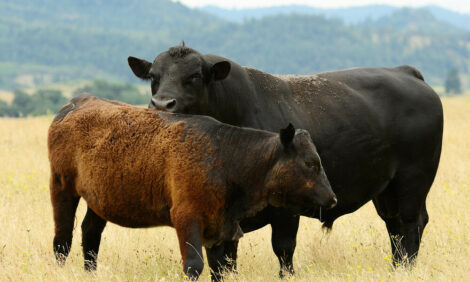



Merck Animal Health Launches a New ‘Creating Connections’ Educational Module
Merck Animal Health, in partnership with the Beef Cattle Institute and Production Animal Consultation (PAC), today released the sixth module in the CreatingConnections™ Educational Series that features industry experts who share unique insights and proven techniques to help ensure low-stress cattle handling.This module, now available at www.creatingconnections.info, focuses on the stress of heat load on cattle, as well as heat stress management practices and their significance in maintaining the animals’ well-being.
“Planning ahead is critical to the effective management of heat stress,” said Grant Crawford, Ph.D., technical services manager, Merck Animal Health. “Feedlots should determine their risk of heat stress based on feedlot type, cattle type, water space and other environmental factors, and plan accordingly. High heat loads can put tremendous stress on cattle and, if not managed appropriately, can result in decreased ration intake, poor performance, a myriad of health issues and death loss.”
Dr Crawford also noted it’s important to understand that heat load is about more than just the temperature on the thermometer. It also involves humidity, wind and solar radiation. “With the right techniques and keeping a keen eye on short- and long-term weather conditions, though, producers can help recognise the early signs of heat stress and help mitigate its impact,” he adds.
The new module, which is comprised of several video lessons, provides important information and management practices that producers can implement immediately to help ensure the well-being of their cattle during periods of high heat. According to Kevin Sullivan, BVSc, Partner, PAC, producers should keep the following things in mind when working to manage heat stress.
Utilise shade, air movement, water and feedlot design to help reduce heat load; extra water tanks should be on hand, if needed.
- Keep the perimeter of feedlot pens clean from standing water or weeds as these may attract flies, further exacerbating stress associated with heat.
- Sprinklers can be very useful, but feeders must ensure that they cover enough space, otherwise cattle will crowd under the sprinkler. Sprinkling should be completed by early-to-mid morning. Otherwise, it will contribute to increased humidity in the pens and will be of very little benefit.
- If it appears that heat stress days are imminent, feed deliveries should be static and possibly decreased to reduce the amount of feed wastage. A larger portion of the feed delivery should be fed in the afternoon rather than morning to allow cattle to carry the heat load associated with feed intake into the evening rather than the day.
- Avoid working cattle during temperature extremes; handle them early in the morning.
Dan Thomson, D.V.M., Ph.D., the Jones Professor of Production Medicine and Epidemiology at Kansas State University, served as moderator for this module, which can be accessed at http://www.creatingconnections.info/en-US/Home/Index.
| TheCattleSite News Desk | More MSD Animal Health News |



